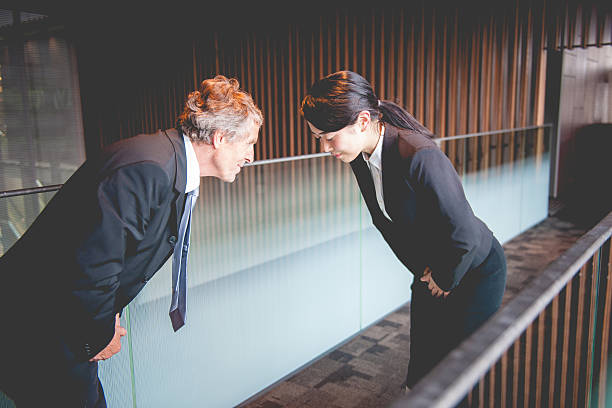
The Reason Why The Japanese Bow
What is one aspect of Japanese culture that most of us are aware of? Yes, it is the bowing etiquette. While many people know about the Japanese culture of bowing, most of us are unaware of the actual reasons behind that.
The Japanese bow to each other as it is used as a show of respect, apology, devotion, and also as a form of introduction. Bowing is a basic human movement that comes naturally and for the Japanese, it is a simple way of exchanging greetings. In addition, it is also a method of showing respect that does not involve physical contact. It is the depth of the relationship between two people and the present occasion that determines the exact form of the etiquette.
Looking back, we can say that bowing had an impact on all the major cultures across the world. Even though it has mostly disappeared in Europe the United States, some cultures still practice it in Asia. However, none of those practices go as deep as the custom of bowing in Japan. I must say, this is one etiquette that sets Japan apart from any other country. So let us discover the various aspects of this age-old tradition in this article.
Reasons behind Japanese bowing
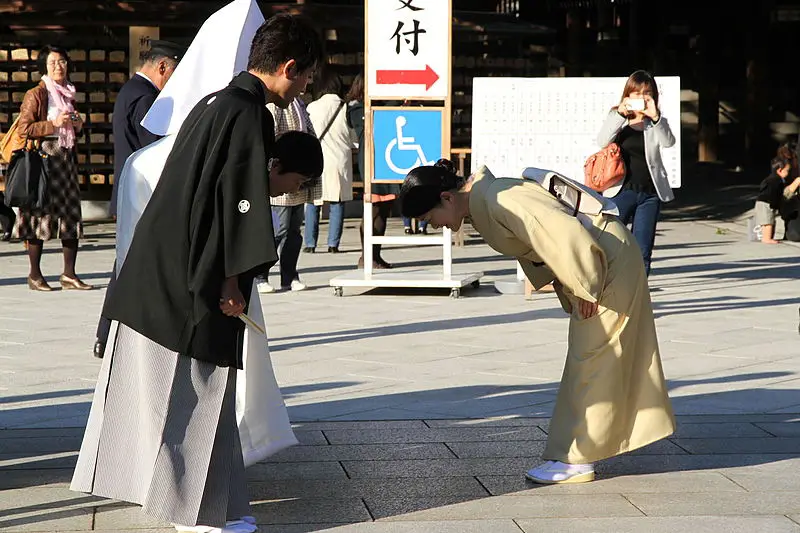
“Ojigi”, as bowing is called in Japanese, is more than a gesture. It is used as a sign of respect, greeting, apology, and even gratitude. The most common bow is the eshaku which is a light bow at a 15 -degree angle. Interestingly, Japan is a hierarchical society at its core. The social behavior in Japan and specifically the custom of bowing is dependent on the status of a person one is interacting with. The basic style of the bow depends on this awareness.
Looking back, bowing started in the Asuka and Nara periods. This is when Chinese Buddhism was introduced in the country. In Buddhist teachings, bowing is a way of showing devotion and respect towards a spiritual master. It is also said that bowing was originally a part of ‘samurai’s etiquette’. It was only during the Edo period (1603 to 1868) that the custom spread all through society.
You may ask why the practice is uncommon in the West? One reason is, bowing is driven by a respect for social positions and this is a concept that is frowned upon in the social structure of America and Europe. But in Japan, the situation is slightly different.
There are different variations of bowing in Japan and the degree of a bow is an important aspect. Note that a bow can range from 15 to 90 degrees depending on the social circumstances and the people involved. For Japanese people, it is a must to know the correct forms of bowing.
When to bow?
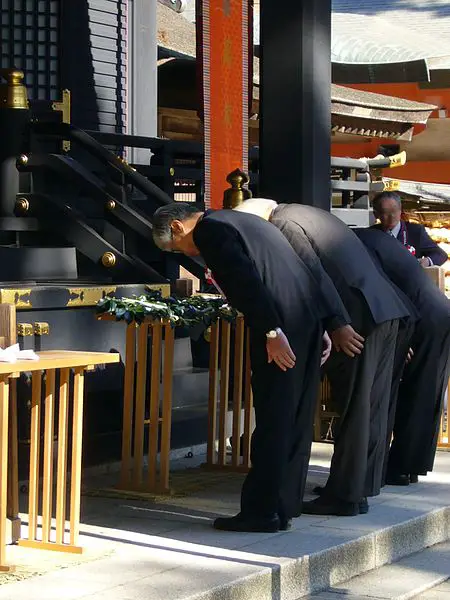
Bowing is one ancient custom that is still practiced widely in Japanese society and has immense social relevance. So when a person bow, they can have any one of the objectives stated below:
- Starting or ending a ceremony, class or meeting
- Saying hello or goodbye to somebody
- Thanking somebody
- Congratulating somebody
- Apologizing to somebody
- Expressing devotion to something or someone
- Asking someone for a favor or goodwill
Instead of simply focusing on the occasion, it is important to remember that bowing can convey different emotions like respect, appreciation, and remorse. The important thing is, bowing is not just a physical gesture. The motive behind the gesture is to express deeper human feelings. So the depth and duration of the bow is dependent on the inner emotions of the individual.
Types of bows
Sitting and standing bows
You will find different types of bows being practiced in Japan but there are two main positions from where you can begin a bow. One is the seated position known as seiza and the other is a standing position known as seiritsu.
In seiza, one may be seated in all types of formal situations, ranging from mourning at a funeral to participating in a tea ceremony. To get into the position, you start by kneeling. Traditionally, women put both knees on the ground at the same time and men should kneel one leg at a time.
The top of your feet will be flat on the floor and the toes will be pointed back behind you. Keep the arms loosely at your sides and place the palms on the thighs. Next, try to sit with your spine comfortably erect. Surely, this will sound a bit complicated for first-timers. But with some practice, you can do it with ease.
Coming to the seiritsu or the standing bow, you need to stand and look ahead to a spot about 18 ft in front of you. Men need to position their feet about 3cm apart and women need to make sure that their feet are touching. Next, place the hands on the thighs at a diagonal and keep a fist worth of distance between the body and the elbows. Now, you are ready to bow.
Keep in mind that general bows do not last more than a second. But, bows of sincere apology last longer than others. In general, deeper bows or saikeiri show apology, sympathy, worship, and great respect. A slow, deeper bow is also reserved for seniors or those in high positions like judges, diplomats, and people of rank.
To bow or to shake hands?
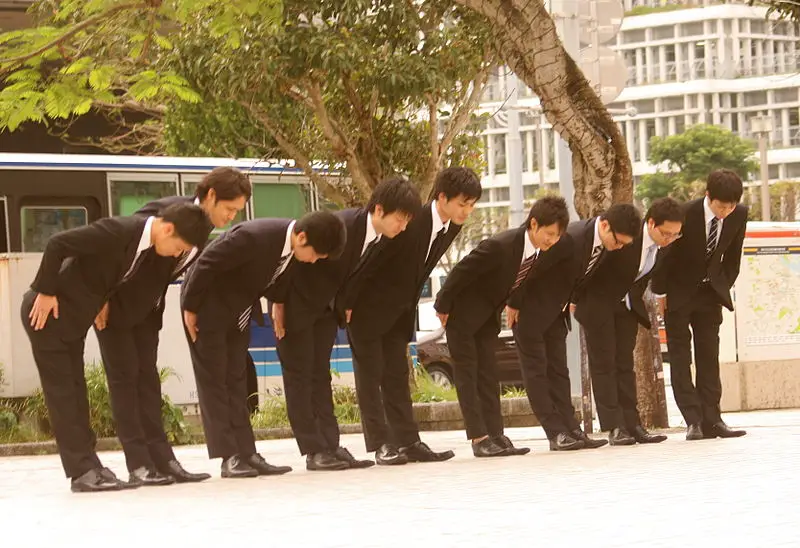
In meetings, most Japanese offer a handshake to make it convenient for Non-Japanese individuals. In more formal settings, a combination of bows and handshakes are often used. However, if you are not sure whether to bow or to shake hands, opt for a bow. Shaking hands is usually preferred by close friends when congratulating.
In case you are in an event, just follow the hosts’ lead to decide what will come first. You should try your best to return the bow when you are offered one. The fact is, shaking hands is a very rare custom between the Japanese, and doing so indicates a very strong relationship.
To make things clear, both bows and shakes are suitable for formal greetings. However, avoid making the common mistake of bowing while the other person offers a handshake. Also, avoid any embarrassment by showing an undue interest in bowing. Most importantly, when you notice that the other party is ready for a handshake, do not start to bow.
It is easy to judge if a person will bow first while you are moving towards one another. You will notice that they stop at a significant distance with their feet together. Note that a Japanese handshake is mostly limp and there is little to nil eye contact.
In some cases, Japanese people can bow and shake hands one after the other. In reality, there is no need to mix the two. Also, actions like hugging or shoulder slapping are not gestures that are not practiced in public in Japan.
How to get the bow right
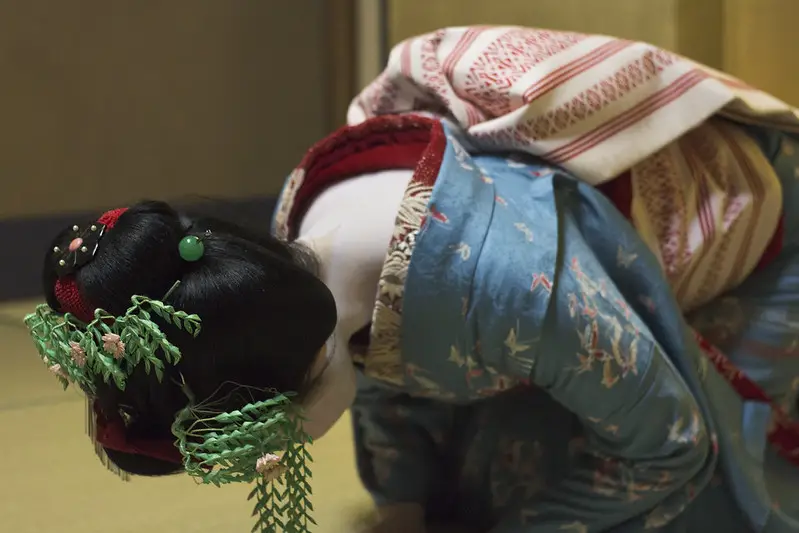
The best way to bow correctly in Japan is to slightly bend your waist while keeping the neck and back straight and feet together. When bowing, you need to directly face the person you intend to greet but keep your eyes low while you bow. At the same time, your arms should be straight at the side and fists should remain open.
What if you have something in your hand like a briefcase? Bowing while holding it is fine or else, you can simply put it down. If you receive a business card, you need to receive it with both hands to show respect and take a slight bow.
The longer you hold and the deeper your bow, the more submission, and respect are shown. For an informal, quick bow, you can bend just about 15-degrees. On the other hand, a formal bow will need you to bend more, close to a 30- degree angle. A deep bow will involve bending to complete 45-degrees and looking at the shoes.
Keep the gaze down as you bow
You need to remember that keeping eye contact when you bow is considered as a bad etiquette and can even be considered as threatening. Pick a spot on the ground in front of you and look there. In some cases, people find themselves bowing more than once until one person stops the formal process. However, every subsequent bow will not be as deep as the first one.
Suppose you have to bow within a cramped space. Quite simply, you can move slightly to the left to avoid knocking your head with the other person. Once you exchange bows, give a warm smile and a casual eye contact.
Keep in mind that bowing for too long or bowing too deeply will lead to the other party feeling obliged to bend down for another round of bowing. The fact is, a lot of Japanese individuals, when they meet foreigners, look forward to shaking hands. At the same time, they can bow every time they meet a person or a friend in a day.
Japanese organizations consider bowing to be extremely important and they even train their employees in the same. Making an effort and showing that you are aware of the culture and bowing etiquette in Japan will go a long way in earning respect.
Japanese have strong reasons for bowing and it is one tradition that makes their culture so unique. You might not be able to learn the exact way of bowing but it is important to respect the tradition. Bowing is one deeply-rooted custom that will indicate your reverence for Japanese customs.




